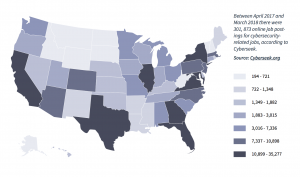This article is an excerpt from GovLoop’s recent report titled “Your Guide to Key Advancements in Government Cybersecurity.” Download the full report here.
Globally, projections suggest there will be a cybersecurity workforce shortage of 1.8 million by 2022, according to a May 2018 joint report to the President from secretaries at the Commerce and Homeland Security departments.
“Positions needing to be filled range from entry-level jobs that can be performed by high school graduates who have received additional training through coursework, apprenticeships, or on-the-job experience, to the most knowledge- dependent, requiring advanced degrees coupled with lengthy on-the-job experience,” the report found.
But despite the need for a wide range of talent, there’s concern about the abundance of mid-level openings,
most of which require a bachelor’s or master’s degree and at least three years of experience, according to that same report. This suggests that “creating more entry-level jobs would offer opportunities for acquiring and developing talent.”
At the federal level, agencies are just starting to gain some clarity around the size and critical needs among the cybersecurity workforce, per a 2015 law and accompanying Office of Personnel Management guidance.
But when it comes to hiring, there is no standardized, governmentwide assessment for validating employees’ skills, which can be challenging if hiring managers aren’t adept at identifying a candidate’s technical competencies. Other roadblocks include competition from other public-sector agencies and private companies, hiring freezes, and modest compensation packages. Despite these challenges, some agencies are making progress to improve hiring and employee training.





Leave a Reply
You must be logged in to post a comment.